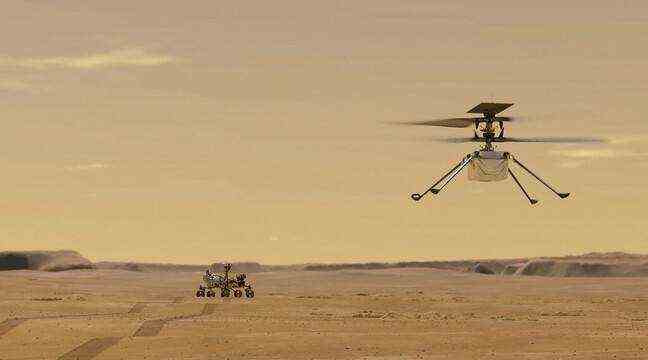This is what the small Ingenuity helicopter should look like in flight. (drawing) – HANDOUT / NASA / JPL-CALTECH / AFP
We are almost there. The first flight of NASA’s Ingenuity mini-helicopter to Mars could take place as early as Monday, the US space agency said on Saturday after a delay of more than a week due to a technical issue. The journey of Ingenuity, the very first flight of a motorized device to another planet, must allow NASA to collect invaluable data on the conditions of life on Mars.
“NASA expects the first flight of its Ingenuity Mars helicopter to take place from Monday April 19,” the agency said. Data could be received “a few hours after the autonomous flight” which should start around 3:30 am (7:30 am GMT), according to NASA.
A real challenge
The flight is a real challenge, because the Martian air is of a density equivalent to only 1% of that of the Earth’s atmosphere. However, it is by pushing the air while turning that the propellers can lift the device. This means that Ingenuity has to spin its rotor blades much faster than a helicopter on Earth would in order to fly.
After the flight, the helicopter will transmit technical data to the rover on what it has achieved, which will in turn be sent to Earth. Among this early data, there will be a black and white photo of the ground taken by Ingenuity directly below it when it is in the air.
Pictures the next day
The next day, once its batteries are recharged, the helicopter will transmit a color photo of the horizon, taken by its other camera. But the most spectacular images should come from the Perseverance rover, placed for observation several meters away, and which must film the flight.
If successful, the second flight may take place no more than four days later. Up to five flights in all are planned, of increasing difficulty. NASA would like to be able to raise the helicopter up to 5 meters in height, then try to make it move sideways.
The operation will be the equivalent on Mars of the first flight of a motorized vehicle on Earth, in 1903, by the Wright brothers. A piece of fabric from this aircraft that took off more than a century ago in North Carolina in the United States has even been placed on board Ingenuity. Whatever happens, after a month or less, the Ingenuity experiment will stop, leaving the Perseverance rover to devote itself to its main task: to search for traces of ancient life on Mars.

